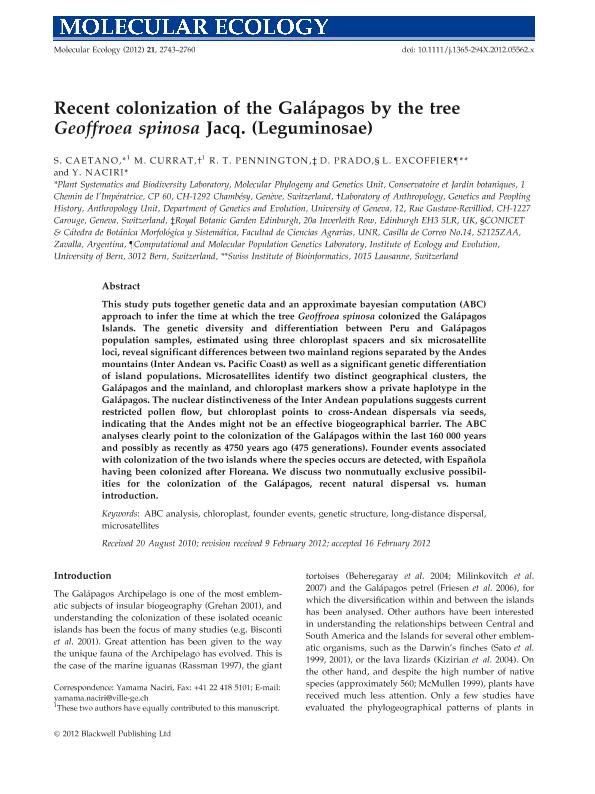Mostrar el registro sencillo del ítem
dc.contributor.author
Caetano S.
dc.contributor.author
Currat M.
dc.contributor.author
Pennington, R. T.
dc.contributor.author
Prado, Darien Eros

dc.contributor.author
Excoffier L.
dc.contributor.author
Naciri, Y.
dc.date.available
2023-03-01T11:19:43Z
dc.date.issued
2012-04
dc.identifier.citation
Caetano S.; Currat M.; Pennington, R. T.; Prado, Darien Eros; Excoffier L.; et al.; Recent colonization of the Galápagos by the tree Geoffroea spinosa Jacq. (Leguminosae); Wiley Blackwell Publishing, Inc; Molecular Ecology; 21; 11; 4-2012; 2743-2760
dc.identifier.issn
0962-1083
dc.identifier.uri
http://hdl.handle.net/11336/189165
dc.description.abstract
This study puts together genetic data and an approximate bayesian computation (ABC) approach to infer the time at which the tree Geoffroea spinosa colonized the Galápagos Islands. The genetic diversity and differentiation between Peru and Galápagos population samples, estimated using three chloroplast spacers and six microsatellite loci, reveal significant differences between two mainland regions separated by the Andes mountains (Inter Andean vs. Pacific Coast) as well as a significant genetic differentiation of island populations. Microsatellites identify two distinct geographical clusters, the Galápagos and the mainland, and chloroplast markers show a private haplotype in the Galápagos. The nuclear distinctiveness of the Inter Andean populations suggests current restricted pollen flow, but chloroplast points to cross-Andean dispersals via seeds, indicating that the Andes might not be an effective biogeographical barrier. The ABC analyses clearly point to the colonization of the Galápagos within the last 160 000 years and possibly as recently as 4750 years ago (475 generations). Founder events associated with colonization of the two islands where the species occurs are detected, with Española having been colonized after Floreana. We discuss two nonmutually exclusive possibilities for the colonization of the Galápagos, recent natural dispersal vs. human introduction.
dc.format
application/pdf
dc.language.iso
eng
dc.publisher
Wiley Blackwell Publishing, Inc

dc.rights
info:eu-repo/semantics/openAccess
dc.rights.uri
https://creativecommons.org/licenses/by-nc-sa/2.5/ar/
dc.subject
ABC ANALYSIS
dc.subject
CHLOROPLAST
dc.subject
FOUNDER EVENTS
dc.subject
GENETIC STRUCTURE
dc.subject
LONG-DISTANCE DISPERSAL
dc.subject
MICROSATELLITES
dc.subject.classification
Ecología

dc.subject.classification
Ciencias Biológicas

dc.subject.classification
CIENCIAS NATURALES Y EXACTAS

dc.title
Recent colonization of the Galápagos by the tree Geoffroea spinosa Jacq. (Leguminosae)
dc.type
info:eu-repo/semantics/article
dc.type
info:ar-repo/semantics/artículo
dc.type
info:eu-repo/semantics/publishedVersion
dc.date.updated
2023-02-27T17:44:47Z
dc.journal.volume
21
dc.journal.number
11
dc.journal.pagination
2743-2760
dc.journal.pais
Reino Unido

dc.journal.ciudad
Londres
dc.description.fil
Fil: Caetano S.. No especifíca;
dc.description.fil
Fil: Currat M.. Universidad de Ginebra; Suiza
dc.description.fil
Fil: Pennington, R. T.. Royal Botanic Gardens; Reino Unido
dc.description.fil
Fil: Prado, Darien Eros. Universidad Nacional de Rosario. Facultad de Ciencias Agrarias. Departamento de Biología. Cátedra de Botánica Morfológica y Sistemática Agronómica; Argentina. Consejo Nacional de Investigaciones Científicas y Técnicas. Centro Científico Tecnológico Conicet - Rosario; Argentina
dc.description.fil
Fil: Excoffier L.. University of Bern; Suiza
dc.description.fil
Fil: Naciri, Y.. No especifíca;
dc.journal.title
Molecular Ecology

dc.relation.alternativeid
info:eu-repo/semantics/altIdentifier/url/https://onlinelibrary.wiley.com/doi/10.1111/j.1365-294X.2012.05562.x
dc.relation.alternativeid
info:eu-repo/semantics/altIdentifier/doi/http://dx.doi.org/10.1111/j.1365-294X.2012.05562.x
Archivos asociados
